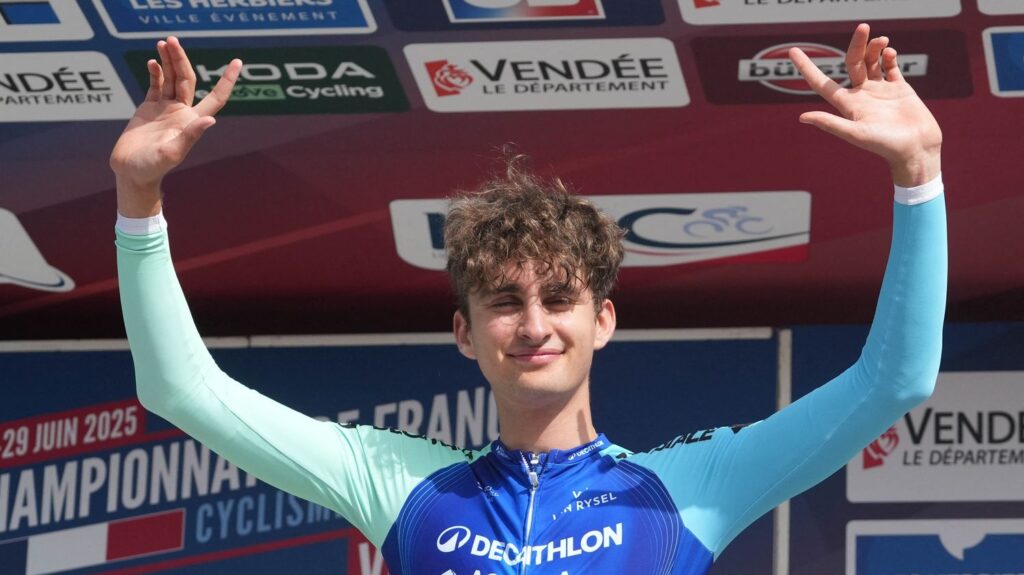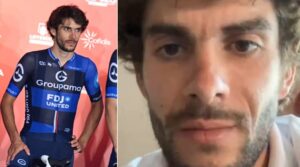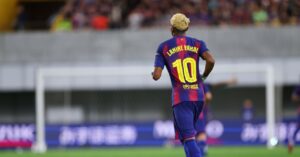
Before, perhaps, tu the summits of the Tour de France, the best world hopes of cycling have their flagship race. It is called the tour of the future, and begins on Saturday August 23, with this year the presence of Paul Seixas (Decathlon-Ag2r La Mondiale), which will be measured for a week to the best runners under 23 years of age.
This race, created in 1961 by the former journalist Jacques Marchand and who is still taking place in France, has, since that date, tried to keep its double peculiarity: only runners between 18 and 23 years old, and who compete in national teams. “The vocation has always remained the same: C'is the Tour de France for young people, even if there have been changes in regulations, age categories “, summarizes Philippe Bouvet, former journalist at The team And Radio Tour voice, now a stakeholder in the race.
Reveal yes, but also find. In its creation, in 1961, professional cycling was limited to France, Italy, Belgium or Spain, but hardly more. The tour of the future was then a unique opportunity to observe runners from more distant countries, like Morocco or … the USSR, in the middle of the Cold War. “At the creation, there were two cyclisms and two worlds which were ignored, which knew that they existed, but which had very little exchanges “rewind Philippe Bouvet.
The victory of Sergei Soukhoroutchenkov in 1978 (then in 1979), the first of a Soviet, was the first marking event in a still fractured Europe between the two blocks. The victory of “Bernard Hinault of the Eastern Bloc”future Olympic champion in Moscow in 1980, was one of the first steps in the globalization of cycling wanted by the turn of the future. “From there, cycling has evolved, because cycling geopolitics has evolved, and the race was opened not only to amateurs but also to professionals from 1981”specifies Philippe Bouvet. In 1980, the victory of the first Colombian, Alfonso Flores, confirmed the international and pioneer dimension of the race, since it was not until 1987 to see a Colombian, Luis Herrerawin a big tour.
The victory of Isaac Del Toro in 2022, has finished completing this internationalization. “”I find that it is symbolic of the culmination of this, because if the turn of the future was not open to national teams, Del Toro would never have participated “welcomes Philippe Bouvet. At that time, Mexican played in a team based in … Saint-Marin. “This allows you to discover new talents because for 30 years, we did not have a Mexican on the bicycle”confirms Bernard Hinault, ambassador of the event.
/2025/08/20/000-48fh2w3-68a5c0dfb0dda227680545.jpg)
The race, with the fragile economic model still today, has almost almost disappeared. It did not take place in 1975 and 1991 for lack of means, and changed several times by name. Between 1986 and 1990, she had even forgotten her principles, namely called the European Community. More age limit, which allowed Miguel Indurain, Marc Madiot or Laurent Fignon to go and register their name on the prize list. The race returned to its original name in 1992, before regaining its initial format since its acquisition in 2007 by A-Velo.
If the years 1990-2000 were “Erratic” According to Philippe Bouvet, with “many who have been caught up in doping “, The turning point in the 2010s gave its letters of nobility to the turn of the future, which has so far seen seven future winners of the Tour de France win the event: Felice Gimondi, Joop Zoetemelk, Greg Lemond, Miguel Indurain, Laurent Fignon, Egan Bernal and … Tadej Pogacar. In 2018, the Slovenian won the event before passing professional the following year.
“Pogacar was barely 19 years old, he was really a teenager. He hadn't made great exploits, but every day, he was attacked from all sides. And every day, he restored the situation. He had impressed me. I said to myself:” But who is this guy? It's Merckx? “I may not have really mistaken myself.”
Philippe Bouvet, former cycling journalist at the team and member of the Tour of the futureIn Franceinfo: Sport
But is the turn of the future the last compulsory passage in hopes for future champions, at the time of ever earlier professionalization and visibility? “DIn the past, we took the top 5 of the Tour of the future, and in the process, they signed a contract. You were doing a great thing there, it's good, you signed pro. Now this is no longer the case. If you want to go and detect a talent around the future, it's already too late. You must almost take the 20th or 30th place to have a free -free runner “notes our consultant Lilian Calmejane. “Now, professional teams do not hesitate to recruit from the cadets (15-16 ans). Everyone gets caught up in Remco Evenepoel but there is only one“, Abunders Philippe Bouvet.
/2025/08/20/e6922ffcd26161b922ffcd261ee922v-960x640-68a5c01c69101145983301.jpg)
If Tadej Pogacar won it, other stars of today disputed it without shining, like Vingegaard (66th in the same year as Pogacar), or even passed, like Remco Evenepoel. “”Remco went from junior to pro, he did not go to the teeth on the tour of the future. So we will say that this is not 100% compulsory passage “, continues Lilian Calemjane, for whom the turn of the future remains an excellent revealer. “MEven if you have signed with the pros, you have to go rub it, especially if you are considering a career of general classification and large tour. It's a real springboard “.
A springboard that will allow the two pearls of the cycling of tomorrow, the French Paul Seixas and the Belgian Jarno Widar, to finally compete. “”Jarno Widar, it's almost the biggest hopes of all time. I was around the Isard, which is also a very famous race in the mountains, you speak of Jarno Wildar among young people, they all drool in front of him. It's like in pros for pogacar “presents Lilian Calmejane.
The Belgian, unlike French, still runs as a development team at the Belgian team Lotto, while Paul Seixas went directly from the junior category to pros at Decathlon-Ag2r La Mondiale. “For the past two years, Widar has been running at the Loto Development with the whole team at his service, he knows how to federate around him, he really runs like a leader on the Tour de France. It's a crazy thing”continues Lilian Calmejane. “What struck me is that they run more and more like pros. We feel that they are formatted, that they are already physically in preparation and in strategy, they are already mature”abounds Philippe Bouvet.
/2025/08/20/maxsportsworldtwo963252-68a5bf3e4cd5c633983412.jpg)
Winner last year of the Giro Next Gen, the Tour of Italy Hopes, Jarno Widar will have a crowded customer to manage with Paul Seixas. “”Seixas is a phenomenon. To make 8th to his first runner -up at 18 is crazy. If it displays the same level, then it is still a notch above. It will be a beautiful duel, a bit like Pogacar against Vingegaard “, Ose Serge Pauwels, the Belgian coach, Direct Velo. “I still put a play on Seixas because it is more complete. On the whole week, I think he will have fewer flaws than Widar”estimates Lilian Calmejane.
In the event of final success, the French would become the youngest winner of this race already won by David Gaudu (2016) On the female edition that has existed for three years. What maintain the status of precursor of the Tour de l'Avenir, which was also the first race to flush out the Col de la Loze in 2019, and also serves as a test for future race commissioners.


